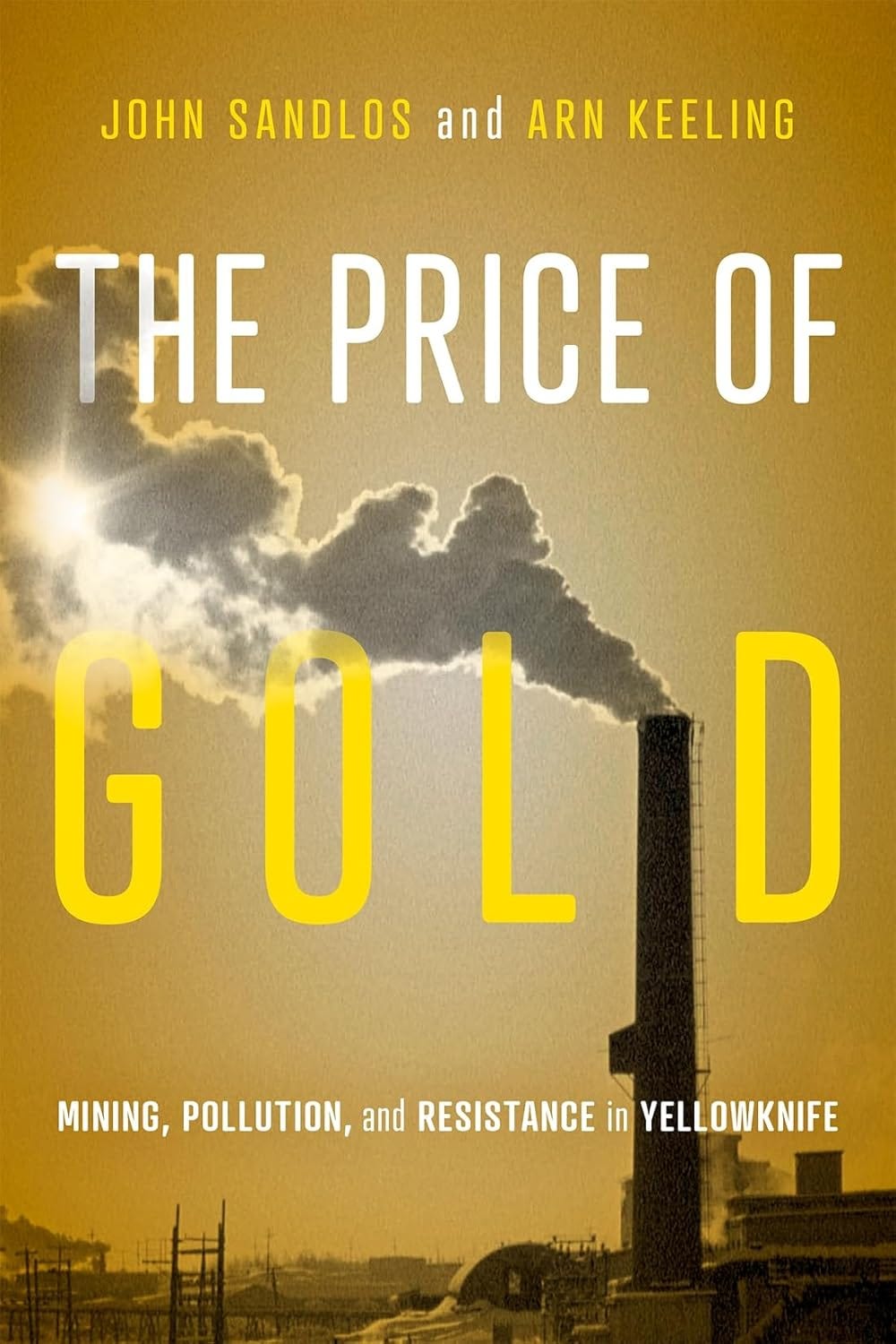The Price of Gold: Mining, Pollution, and Resistance in Yellowknife by John Sandlos and Arn Keeling
Reviewed by Dawn Macdonald
Enough arsenic is buried at the defunct Giant minesite to poison every person on the planet, let alone in the nearby city of Yellowknife, NWT (population 20,000) or the Dene community of Dettah (population 200). Arsenic trioxide is released when ore containing an arsenic-bearing compound, arsenopyrite, is roasted to extract gold. The arsenic waste can go one of two places: into the air from the top of the smokestack, or into a filtration system designed to capture at least some of this toxin at the source.
“So it kind of destroyed the whole Yellowknife area for us, not only Giant Mine but the whole Yellowknife area because it used to be a really good place for animals.”
Over the 50-year lifetime of the Giant mine, this material went both of these places. An uncountable quantity was released into the environment. The other 230,700 tonnes of dust that was contained at the site now needs to be maintained in a stable condition. Keeping it stable underground means keeping the ground frozen, but Yellowknife is in a discontinuous permafrost zone which is progressively thawing. There’s a freezing system in place right now which will require ongoing maintenance in perpetuity, or until another solution is found.
The minesite was once a legendary berry picking spot. The Yellowknives Dene would stop by on their seasonal rounds, but took care never to overstay their visits, to avoid disrupting the natural abundance of the area. The lake was important for fishing, and moose frequented the shore where Yellowknife sits today. “So when the prospectors, they came, you know, they just plopped themselves everywhere and anywhere without any consultation of our people, or even ask anyone,” noted one unnamed Elder in source documents quoted in The Price of Gold. “So it kind of destroyed the whole Yellowknife area for us, not only Giant Mine but the whole Yellowknife area because it used to be a really good place for animals.”
That lack of consultation is a powerful theme throughout the history of mining in Yellowknife, and across the Canadian North. Gold mining at Giant made money for some, but not for the people whose land was affected. The costs of environmental remediation are estimated to be slightly in excess of the valuation of the mine’s total gold output. The disparity in costs and benefits to the Yellowknives Dene is especially stark. Between 1948 and 2004, arsenic contamination from mine operations cost them access to clean water from the lake, a pattern of subsistence based on fishing and harvesting of wild foods, and the life of at least one child (with three additional child deaths attributed by the community to arsenic poisoning). When the contamination of the local water source became apparent, the municipality of Yellowknife was able to move its intake to a cleaner location, but members of the nearby Dene community were advised to purchase trucked-in water, made to pay for the resource they had lost. In the words of the First Nation’s lands management director Johanne Black, speaking on CBC’s Ideas in 2017, “they got the gold and we got the shaft.”
Historian John Sandlos and geographer Arn Keeling present a thorough and compulsively readable analysis of the slow-motion disaster that has unfolded at Giant Mine. They identify and cite the many individuals, groups, and government agencies that variously abetted, unmasked, and were affected by the release of arsenic through the gold roasting process. The authors’ exhaustive research, supported and guided by local experts from Indigenous and non-Indigenous communities, covers a wide range of document sources as well as fresh oral history.
Some health effects of arsenic trioxide were known (but discounted) from the beginning of the mine’s operation, while others (such as its status as a carcinogen) were not identified until much later on. The authors note the challenges of doing epidemiology in a remote location with a transient worker population. The story of the mine takes into account larger societal movements coterminous with the emergence of local pressures for worker safety, environmental stewardship, and Indigenous-settler reconciliation. Sandlos and Keeling argue that progress was ultimately achieved through “the unwavering determination of Indigenous, environmental, and social justice advocates in Yellowknife,” acting in alliance around a common cause. In approaching remediation, and a solution to the problem of buried arsenic, “local activists thought [the remediation] should also repair broken social and ecological relationships – between people and the land, between Indigenous and settler communities, between industry and the community, and between present and future generations.”
While the ultimate disposition of the buried arsenic dust remains uncertain, Sandlos and Keeling see reason to close on a note of hope.
A PDF excerpt of The Price of Gold can be acquired here.
About the Authors
John Sandlos is history professor at Memorial University of Newfoundland.
Arn Keeling is geography professor at Memorial University of Newfoundland.
About the Reviewer
Dawn Macdonald lives in Whitehorse, Yukon, where she grew up without electricity or running water. She won the 2025 Canadian First Book Prize for her poetry collection Northerny. She posts weekly at Reviews of Books I Got for Free or Cheap (on Substack), as well as reviewing for journals and for The Seaboard Review of Books.
Book Details
Publisher : McGill-Queen’s University Press
Publication date : Sept. 16 2025
Language : English
Print length : 276 pages
ISBN-10 : 0228026172
ISBN-13 : 978-0228026174





